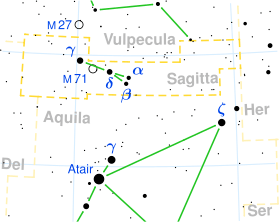Delta Sagittae
 | |
| Observation data Epoch J2000 Equinox J2000 | |
|---|---|
| Constellation | Sagitta |
| Right ascension | 19h 47m 23.26253s[1] |
| Declination | +18° 32′ 03.4401″[1] |
| Apparent magnitude (V) | +3.82[2] (3.91[3] / 6.64)[4] |
| Characteristics | |
| Spectral type | M2II + B9.5V[4] |
| U−B color index | +0.98[5] |
| B−V color index | +1.40[5] |
| Astrometry | |
| Radial velocity (Rv) | 2.5 ± 0.9[6] km/s |
| Proper motion (μ) | RA: -4.31[1] mas/yr Dec.: 12.35[1] mas/yr |
| Parallax (π) | 5.49 ± 0.72[1] mas |
| Distance | approx. 590 ly (approx. 180 pc) |
| Absolute magnitude (MV) | −2.58[7] |
| Orbit[4] | |
| Period (P) | 10.11 yr |
| Semi-major axis (a) | 0.051″ |
| Eccentricity (e) | 0.44 |
| Inclination (i) | 140.0° |
| Longitude of the node (Ω) | 170.2° |
| Periastron epoch (T) | 1979.93 |
| Argument of periastron (ω) (secondary) | 257.7° |
| Details | |
| δ Sge A | |
| Mass | 3.35+0.335 −0.30[8] M☉ |
| Radius | 129+13 −12[8] R☉ |
| Luminosity | 2500[8] L☉ |
| Surface gravity (log g) | 0.74 ± 0.10[8] cgs |
| Temperature | 3600+288 −267[8] K |
| δ Sge B | |
| Mass | 2.9[4] M☉ |
| Radius | 2.6[4] R☉ |
| Luminosity | 63[4] L☉ |
| Temperature | 10000[4] K |
| Other designations | |
| Database references | |
| SIMBAD | data |
Delta Sagittae (Delta Sge, δ Sagittae, δ Sge) is a binary star in the constellation of Sagitta, with an apparent magnitude of +3.68. The primary component is a red M-type bright giant, and the secondary is a B-type main-sequence star.[2] It is approximately 590 light years from Earth, based on its parallax.[1]
Delta Sagittae is a spectroscopic binary with a composite spectrum, meaning that light from both stars can be detected. It has an orbital period of about 10 years and an eccentricity of about 0.44.[4]
Delta Sagittae is moving through the Galaxy at a speed of 9.8 km/s relative to the Sun. Its projected Galactic orbit carries it between 23,800 and 35,300 light years from the center of the Galaxy.[9]
Naming
In Chinese, 左旗 (Zuǒ Qí), meaning Left Flag, refers to an asterism consisting of δ Sagittae, α Sagittae, β Sagittae, ζ Sagittae, γ Sagittae, 13 Sagittae, 11 Sagittae, 14 Sagittae and ρ Aquilae. Consequently, δ Sagittae itself is known as 左旗三 (Zuǒ Qí sān, English: the Third Star of Left Flag.)[10]
References
- 1 2 3 4 5 6 van Leeuwen, F.; et al. (2007). "Validation of the new Hipparcos reduction". Astronomy and Astrophysics. 474 (2): 653–664. arXiv:0708.1752. Bibcode:2007A&A...474..653V. doi:10.1051/0004-6361:20078357.
- 1 2 "* del Sge". SIMBAD. Centre de données astronomiques de Strasbourg. Retrieved 23 February 2017.
- ↑ Calculated from subtracting magnitudes.
- 1 2 3 4 5 6 7 8 Eaton, Joel A.; Hartkopf, William I.; McAlister, Harold A.; Mason, Brian D. (1995). "Winds and accretion in delta Sagittae". Astronomical Journal. 109 (4): 1856–1866. Bibcode:1995AJ....109.1856E. doi:10.1086/117412.
- 1 2 Mermilliod, J.-C. (1986). "Compilation of Eggen's UBV data, transformed to UBV (unpublished)". Bibcode:1986EgUBV........0M.
- ↑ Wilson, Ralph Elmer (1953). "General catalogue of stellar radial velocities". Bibcode:1953GCRV..C......0W.
- ↑ Anderson, E.; Francis, Ch. (2012), "XHIP: An extended hipparcos compilation", Astronomy Letters, 38 (5): 331, arXiv:1108.4971, Bibcode:2012AstL...38..331A, doi:10.1134/S1063773712050015.
- 1 2 3 4 5 Schröder, K.-P.; Cuntz, M. (2007). "A critical test of empirical mass loss formulas applied to individual giants and supergiants". Astronomy and Astrophysics. 465 (2): 593–601. arXiv:astro-ph/0702172. Bibcode:2007A&A...465..593S. doi:10.1051/0004-6361:20066633.
- ↑ Delta Sagittae (HIP 97365)
- ↑ (in Chinese) AEEA (Activities of Exhibition and Education in Astronomy) 天文教育資訊網 2006 年 7 月 3 日